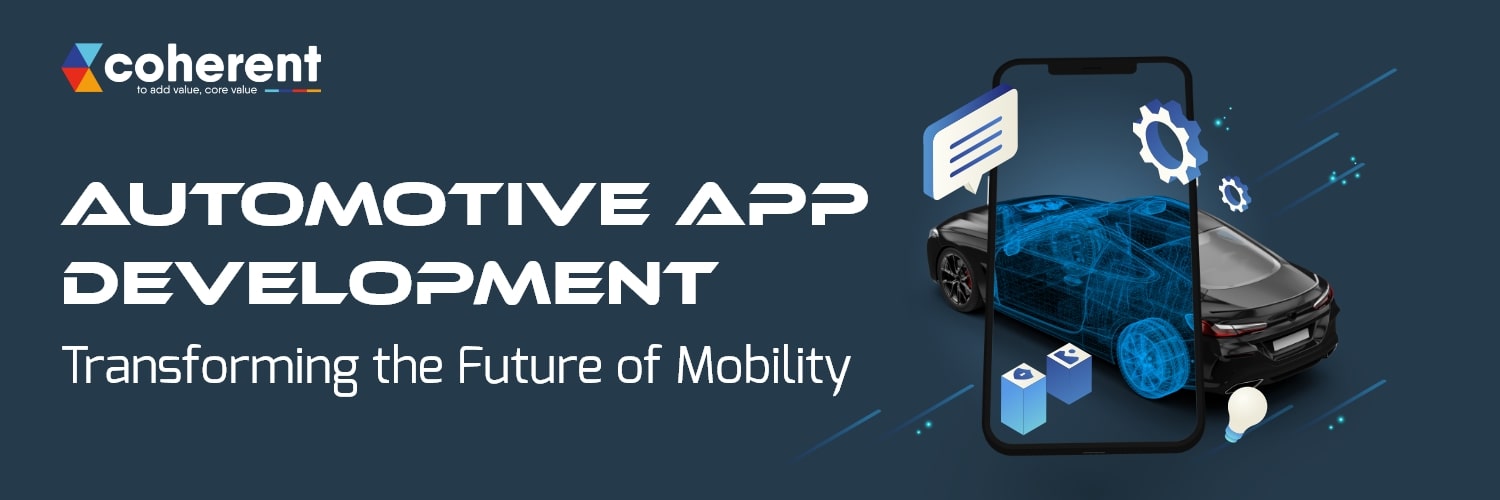Automotive App Development: Transforming the Future of Mobility

As we know automotive app development is transforming the way we drive with vehicles, enabling driving to become intelligent, secure, and networked. Users can monitor the health of their car, get the best route, and even manage some aspects remotely. Think of starting your car, monitoring fuel levels, or setting the AC—directly from your phone! As the usage of AI and IoT grows, automotive apps are also getting more advanced with real-time information and automation. The driving future has arrived, and it's in your hands! So let's check out the automotive app development process in this blog post to be ready to know the future of the vehicle industry.
Understanding Automotive App Development
Automotive app development is changing how we deal with our cars. From locking/unlocking remotely to monitoring vehicle health and obtaining live traffic alerts, automotive applications facilitate driving more simply and intelligently. Appreciated to Artificial intelligence and IoT in automobile app development, automobiles are growing smarter and interconnected, providing voice inputs, foreseen care, and even assisted driving. Automotive app development examples include fleet management, infotainment, navigation, and autonomous vehicles. These developments ensure friendly, safe, and flawless user experiences. With each advance in technology, so come the opportunities—improving safety, ease, and efficiency. For ordinary drivers or automobile enthusiasts, automotive apps are building the future of mobility, with every trip smoother and more pleasant. The future on the road is bright!
Read More: Car Wash Application: Revolutionizing the Way We Keep Our Cars Clean
Automotive App Development Features
In this section we'll gonna describe the key features of Automotive App Development:
Infotainment and Connectivity
Automotive Application Development of today seamlessly integrates with Apple CarPlay, Android Auto, and Bluetooth. Automotive apps provide hands-free music enjoyment, calls, and streaming of media. Automotive apps enhance the in-car entertainment, keep the user connected without the need to glance away from the road, and enhance driving comfort and safety.
GPS Navigation and Tracking
Real-time traffic information, optimized routes, and location tracking allow users to plan the most convenient journey. An automotive design app uses instant feedback on road conditions, recommends alternative routes, and provides location tracking, hence providing easy and convenient travel. The app also enhances fleet management and safety through remote tracking of vehicle movement.
Remote Vehicle Control
Users can turn on the engine, set the air conditioning, lock and unlock doors, and even locate the car with an automotive app. An automotive maintenance app makes it simpler and more secure to control the vehicle from any place. In addition, the user may pre-condition the interior of the car to suit their preferences prior to entering for better remote control.
Safety and Security
Additional amazing safety features include crash prevention, emergency response, driver monitoring, and theft notification. A smart car application makes users more alert, informs authorities in the case of an accident, and notifies the driver in the case of an emergency. Security features offer car owners and fleet operators security against theft, providing enhanced peace of mind.
Vehicle Diagnostics and Maintenance
An automotive app provides engine condition monitoring, fuel consumption monitoring, battery condition notification, and maintenance notifications. Automotive apps keep track of car performance, notify against possible defects, and remind users to carry out maintenance. This solution saves breakdowns, and repair costs and enhances vehicle life overall.
Automotive App Development Process
Here's the step-by-step breakdown to know the automotive app development process:
Research and Planning
Determine the purpose of the app prior to development; it may be infotainment, ADAS, navigation, or car diagnostics. A mobile app development company should evaluate competition products, target audience needs, and market trends. It is necessary to outline primary points of difference and points of contrast. This step aids in creating a crisp roadmap so that the application stays competitive within its marketplace, meets the requirements of the user, and follows common market rules.
Define Features and Requirements
After research and planning you should describe the key features and requirements of the app, which are remote control, GPS tracking, and vehicle-to-vehicle communication. An android app development company can increase performance by adding ADAS, cloud services, AI, and IoT. Also, you need to comply with the industry standards like GDPR and ISO 26262 too. A properly defined feature set makes automotive apps work correctly, securely, and to users' satisfaction.
UI/UX Design
Make an easy-to-use interface specifically designed for in-car use. A car customizing app should prioritize accessibility, minimal driving distractions, and easy navigation. Create wireframes and prototypes for testing functionality and easy control. The goal is a visually attractive, effective, and responsive design that improves the driving experience while remaining safe.
Development & Integration
Select an appropriate technology stack, such as Android Auto, Apple CarPlay, Flutter, or React Native. An iOS mobile app development company should use vehicle connectivity options such as V2V, V2I, and CAN bus integration. Create a strong backend to manage cloud storage and real-time data interchange, ensuring that the app runs smoothly and effectively for users.
Deployment & Launch
Make the app available on websites like Google Play, the Apple software Store, and marketplaces for specialized vehicles. Work together with automakers to guarantee smooth integration of built-in systems. Using over-the-air (OTA) updates helps in increasing security, fixing issues, and adding capabilities over time, which will bring long-term performance and customer satisfaction too.
Maintenance and Updates
Maintenance and updates include monitoring app performance and addressing problems and security issues quickly. Using automotive app development software, release regular updates that include new features and system enhancements. Gather user feedback to keep the app relevant, efficient, and conforming with the most recent automobile technologies and industry standards.
Also Read: How to make Buy & Sell Used Car Mobile App Development- Cost & Features
Conclusion
It is quite a journey to do automotive app development that is properly-fast, secured and an experience you can rely on. Every step in the process, from requirements gathering, app design, development and testing, and updating, once it is out there,it is a little adventure. Every task is crucial to developing a multimedia and an expected automotive application. With advanced technologies such as AI and IoT, the automobile industry is bound to undergo a massive digitized makeover, and these automotive apps are going to revolutionize the way we perceive mobility by ensuring it is safe, efficient, and super convenient. Implementing the newest technology, companies can anticipate new evolving trends in the industry, providing top-notch solutions to consumers—and stay a step ahead of the game. Reach out to us as we are a leading mobile app development company, for the best, innovative and smooth app solutions that are actually according to your needs.
Frequently Asked Questions (FAQs)
Q1. What is an automotive app?
An automotive app is software that offers functionality such as entertainment, navigation, remote control of the vehicle, diagnostics, and safety support. The automotive application offers physical and digital world convergence, making it possible for a person to automate, and exchange real-time data, and experience a connected drive with no disruptions through auto systems, IoT, and cloud platforms integration.
Q2. What is the cost of developing an automotive app?
The price of creating an automotive app varies based on its complexity, features, compatibility with platforms, and development duration among others. Simple apps lay in the range of $20,000 to $50,000, and complex apps that integrate cloud, digital, and AI may lie around $100,000 to $300,000 or above. UI/UX design, security, and post-launch maintenance all affect costs as well.
Q3. What are the essential features of an automotive app?
Among the features featured are: infotainment, GPS Navigation, remote car control, real-time diagnostics, integration of ADAS, IOT connectivity, safety alerts with proximity, and AI-powered voice assistants. Besides improving the performance, safety, and convenience of vehicles, the technologies smarten, connect, and streamline driving to fulfill changing consumer mobility needs.
Q4. What is the time required to develop an automotive app?
The more complex the software, the more features, and the more time is required for testing. Normal automotive apps can take three to six months simply, while rich-featured apps using AI, IoT, and cloud connectivity take nine to eighteen months. This timeline includes research, UI/UX design, development, testing, and changes after the launch.
Q5. What are the current trends in automotive app development?
Latest trends in automotive app development are:
- Features of connected cars: Remote vehicle control, diagnosis, and integration with smart homes.
- Tailored in-car experiences: Infotainment, driver profiles, and personalized settings.
- Assistance through AI: Voice recognition, navigation, and predictive maintenance.
- Electrification emphasis: EV charging, range management, and battery optimization.
- Increased safety: Driver-assistance systems, accident detection, and emergency services.

 +91 774-202-1725
+91 774-202-1725 business@coherentlab.com
business@coherentlab.com USA
USA
 Germany
Germany
 India
India
 UK
UK
